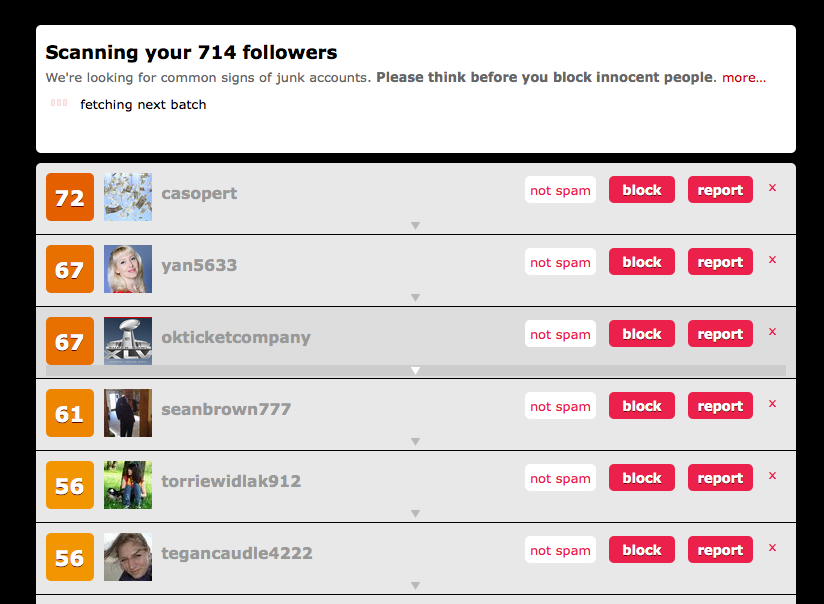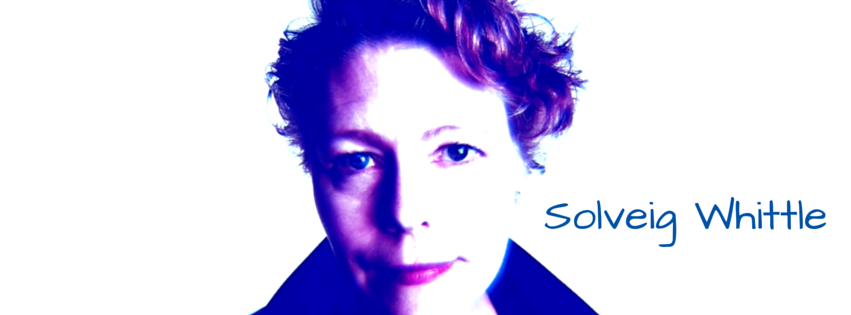 I was physically present (IRL, In Real Life) recently at an event where the Twitter hashtag stream was completely co-opted by twitter spambots. I’ve live-tweeted from a half-dozen tech and cultural events since the beginning of this year, when I first immersed myself in Twitter. I’m very curious about how social media interactions work – and when and why they can go very off-track. When I live-tweet, I try to observe the hashtag stream in real time, usually using Tweetchat.com or setting up a Hootsuite stream. I’ve followed a handful of events remotely via the Twitter hashtag as well, including a recent conference in Boston called Rethink Music (#rethinkmusic). In addition, I participate regularly in a weekly Twitter chat called #ggchat, one of thousands happening all the time in the Twittersphere. Following Twitter hashtag streams has become an integral part of my participation, and that of many others, in this virtual global sociological communications experiment called Twitter.
I was physically present (IRL, In Real Life) recently at an event where the Twitter hashtag stream was completely co-opted by twitter spambots. I’ve live-tweeted from a half-dozen tech and cultural events since the beginning of this year, when I first immersed myself in Twitter. I’m very curious about how social media interactions work – and when and why they can go very off-track. When I live-tweet, I try to observe the hashtag stream in real time, usually using Tweetchat.com or setting up a Hootsuite stream. I’ve followed a handful of events remotely via the Twitter hashtag as well, including a recent conference in Boston called Rethink Music (#rethinkmusic). In addition, I participate regularly in a weekly Twitter chat called #ggchat, one of thousands happening all the time in the Twittersphere. Following Twitter hashtag streams has become an integral part of my participation, and that of many others, in this virtual global sociological communications experiment called Twitter.
Maybe because I’m relatively new to Twitter, I’ve never seen a Twitter stream completely taken over by spambots. I found it fascinating and dismaying at the same time. This article in The Atlantic Wire by Rebecca Greenfield gives a good overview of some of the different ways in which Twitter hashtag streams can get co-opted or become annoying. The stream I was on recently was taken over by the Types 1 and 2 spammers which Rebecca mentions: Porn Bots and Jokesters. I didn’t click on any of the links; I could tell the Porn Bots by their Twitter avatars of scantily clad women and the fact they had few tweets, no followers and were following no one. The other category of spammers I saw which Rebecca doesn’t mention I’ll call Job Bots – these are the same as Porn Bots, except the links they promote are to scammy Craig’s List ads, you know: “Easy job! Earn $500 a week using your computer…”
The live event for this hashtag was an interview and performance by avante-garde cellist, Zoë Keating. Zoë has a pretty substantial social media presence and has done all her own marketing online to promote her music. Her interview was part of an online series done by Chase Jarvis, a Seattle-based, internationally known photographer, social media maven and ardent supporter of the DIY online artist culture. As a result of both Zoë and Chase’s strong social media presence, I suspect there were a large number of social-media-savvy people following the event via the Twitter hashtag, both in the US and outside. I don’t know the statistics for this event, but I asked the Chase Jarvis production team a few months ago how many people follow their live video streams, and they said 10,000 or more. That’s a lot of people participating, actively or passively, in the hashtag stream. Chase’s production team was also running a giveaway promotion with a sponsor, Hewlett Packard, for the best tweet. You had to include the event hashtag, #cjlive, the sponsor’s handle @hpprint, and a link to the streaming event, as well as a quote from Zoë, in order to enter the contest. The prize was a signed photo of Zoë taken by Chase just that morning during pre-production – a big deal for an ardent fan of either artist. The more tweets, the more chances to win. To top that off, Zoë’s performance was amazing to watch – so I think there were a lot of these kinds of tweets: “OMG. You gotta watch this… Amazing…”
I believe these four factors conspired to attract the spambots’ attention (likely just an algorithm in their automated keyword search software):
- savvy international social media following
- large number of participants
- real-time contest (combined with #2 to generate a high number of TPMs, or Tweets Per Minute)
- great live performance that sparked keywords like “amazing” or “gotta watch”
Once the bots appeared, the Twitter stream became useless to the production team to accomplish their goal of promoting the sponsor. More importantly, it became useless to anyone wanting to actually participate in the event remotely. Meanwhile, I had spent precious minutes wasted trying to report and block the spammers. I eventually just gave up watching the Twitter stream and focused on the live performance – probably what I should have done in the first place. (Beware, one of the pitfalls of live-tweeting: it can wreck your actual experience of the event.) 45 minutes after the event ended, I checked the hashtag stream again. The bots were gone, and a slew of (greatly delayed) tweets by real people about the event suddenly appeared on the hashtag stream.
In marketing, online or offline, it’s always an arms race between consumers and advertisers. It is only a matter of time in any marketing cycle before the black hat programmers and advertisers find ways to clutter eyeballs with useless and annoying promotions. It is antithemical to the whole idea of social media as an open, frictionless, and transparent platform for communication and participation to have bots inject spam of any kind into the process, but my old-school marketing brain tells me it was inevitable. I’m sure Twitter will eventually get better at blocking the Twitter spambots, as have email providers, but in the meanwhile, this experience has certainly made me think twice about my participation in both live-tweeting events and Twitter chats.
If you’ve had any similar experiences with spam on Twitter chats, please comment below.
Here’s a helpful article on blocking spambots:
http://sixdegreeswebdesign.com/blog/2011/02/22/spambots-twitter/


5 comments
You opened my eyes to the pitfalls of such a free and uncontrolled stream – to think that porn bots and job bots are infiltrating what I would like to view as a useful and optimistic method of communicating is disappointing. You are right, the inevitable but still unfortunate. Can the good of social media outweigh the “bad” guys? Who am I to judge? We don’t want it to be “controlled” so it goes back to individual responsibility and accountability to control your own environment, something I would rather have then someone else controlling it for me. My favorite comment in your blog is that you ” gave up watching the twitter stream and focused on the live performance – probably what I should have done in the first place.” I agree wholeheartedly with that observation. Are you going to tell more people after the event about your incredible experience that you focused on entirely with a passionate voice because you were wholly focused? Or is it better to tweet in the background and join the constant chatter? Which does the artist, and you more good? Thanks for the insight and shared experience.
Solveig, this is brilliant and I think it brings up a good point. How much can you really absorb by live tweeting during an event?
I find it distracting as a speaker because you are not giving me your all and I know you love to listen to me talk and since it is difficult to capture your twitter stream, you may not remember that take away message.
I think blogging about the event afterwards and discussing the highlights of the speaker’s presentation and putting in a little of your own op-ed will be much longer lived.
Also, using vernacular abbreviations, OMG etc. seem to attract a certain type of bot.
Nazila
Nazila – Thank you for your comments. I agree, live-tweeting seems to me from my limited experience so far to be more of a service to others than to oneself. It can definitely detract from absorbing and participating in an event. I appreciate your perspective that, as a speaker, it is distracting to know an audience member may be tweeting vs. listening attentively, devoting 100% of their brain cycles to being an audience, not a reporter. Perhaps it is true that the time for synthesis and commentary is better left to after the event, not during the event. I have enjoyed the intellectual challenge of trying to absorb, synthesize and comment in real time, and my appreciation for sports announcers has been greatly enhanced. I have yet to decide if live-tweeting is my calling, but it has been an interesting learning process so far.
Great post, Solveig!
I’ve not really been involved in many Twitter chats or been able to live-tweet events just due to my location (I’m in Scotland and the majority of the events that I would want to be live-tweeting are in the US, often at a time that I’m unable to be online). It’s a shame to hear that the various bots are hijacking these now.
It sounds like the bot programmers are getting smarter and are taking advantage of some of the things that make Twitter so great, while Twitter are unable to keep up with the developments they’re making.
Hopefully you’re right – hopefully Twitter will get smarter at blocking these, just like email providers have. But it sounds like they’re developing at such a rate that it’s difficult for Twitter to anticipate what they will do next.
You’ve opened my eyes to something that I didn’t realise was happening. Obviously, we’ve all had encounters with bots on Twitter (some more than others), but I didn’t realise that they had jumped onto Twitter chats and live tweeting events now!
Thank you for your comment, Ross. I think Twitter is getting better at dealing with the bots. I still see them appear in some situations, but have not since seen them take over a hashtag and render it useless, as they did in the case in this post. Interesting to hear fom Madalyn Sklar that she was locked out of Twitter last week during the #ggchat – probably because she retweeted a lot of tweets with links in rapid succession at the end, when participants do their #shamelessplug. Twitter is also cracking down on fake profiles, which reduces the likelihood of bot spamming.
It’s always an arms race between platform developers and advertisers who want to game the platform to get more eyeballs. Look at Facebook’s recent changes to the News Feed. It’s a fascinating back and forth.